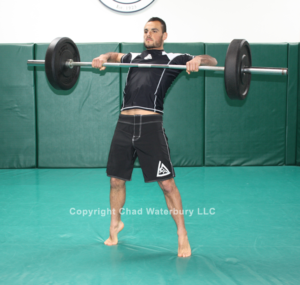The two Olympic lifts, the snatch and clean and jerk, are awesome exercises to build muscle and power. However, both lifts are very technical and most people don’t have the strength, coordination, and mobility to do them correctly. That’s why I like variations of Olympic lifts – particularly the high pull.
What’s so great about the high pull? First, virtually anyone can do it. Second, it’s an outstanding exercise to build the kind of muscle and power that makes you run faster, jump higher, kick harder and deadlift more weight. Third, the high pull, by nature, is designed to be performed explosively. That, of course, ranks it at the top of my list.
Now, even though the high pull is not a complicated exercise, there are some important technique tips. I think it’s actually better to see this exercise in pictures than video. The reason? The combined extension of the hip, knee, and ankle joints (aka “triple extension”) is the most important part of the lift to get right and it’s easier to see in a still picture.
First, warm-up with some mobility work (foam roller, etc), jump rope for a few minutes, then pull two sets of three reps with a moderate load for the deadlift. Be sure to squeeze your glutes hard at the top of the deadlift to activate that important muscle group.
Now you’re ready.
Step #1: Start with a very light load if you’re new to the exercise. About 95 pounds is a good starting point for most men; 65 pounds is usually good for most females.
Step #2: Before you grab the barbell it’s important to get the right stance with your feet. Imagine you’re about to perform a maximum vertical jump – that’s your correct stance. For most people this is slightly wider than shoulder width, but it can vary.
Step #3: Grab the barbell with a slightly-wider-than shoulder width grip. Again, this can vary slightly from person to person. The key point here is that your grip width should feel comfortable and strong. Stand up with the barbell.
Step #4: Push your hips back and let your knees bend slightly as the barbell lowers to about knee height. Your low back should be arched. This is your starting position as shown in the left picture below.
Step #5: Explosively thrust your hips forward as you simultaneously pull the barbell to upper ab/lower chest height with your elbows high. At the peak barbell position your heels should be elevated as shown in the picture on the right.
Step #6: Lower the barbell in a smooth, rapid fashion as your heels return to the floor, your hips push back, and your back stays arched. Explosively reverse the motion as the barbell gets to about knee height.
If pure power/strength is your goal, perform 3-5 sets of 3 reps. If you want more muscle to go with your power, perform 8-10 sets of 3 reps. I like to do this exercise first in your workouts, or it can be combined with an upper body pull (eg, pull-up) and upper body push (eg, dip) in a full body circuit.
I especially like this exercise for fighters because it’s much easier on the wrist joints than a clean and it’s less stressful on the shoulders than a snatch. If you have any shoulder aggravation with this exercise it can be performed with dumbbells to allow a more natural range of motion.
Stay focused,
CW
CW
Wikio


No comments:
Post a Comment